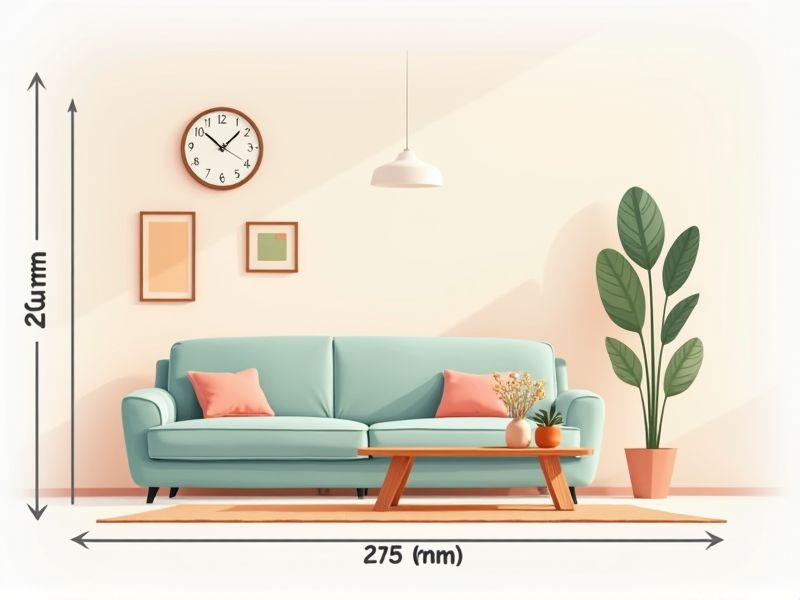
When planning a living room, typical dimensions range from 12 by 18 feet (3.7 by 5.5 meters) for small spaces to around 16 by 20 feet (4.9 by 6.1 meters) for larger, more open areas. It's essential to consider how you'll use the room--if you need space for multiple seating areas or a large entertainment center, aim for the higher end of these dimensions. Leaving at least 2.5 to 3 feet (0.76-0.91 meters) of walking space around furniture helps keep the area comfortable and functional. By understanding these standard measurements, you can plan a living room layout that feels both cozy and spacious for your needs.
Ceiling Height
Ceiling height significantly impacts the perceived spaciousness and overall comfort of a living room, with standard heights typically ranging from 8 to 10 feet. A ceiling height of 9 feet can create a more open atmosphere, enhancing natural light flow and improving ventilation. Rooms with higher ceilings also offer opportunities for creative design elements, such as tall windows or extensive crown molding, which can elevate the aesthetic appeal of your space. For optimal comfort, consider that a ceiling height above 10 feet may require additional temperature control measures for energy efficiency.
Room Width
The standard measurement for a comfortable living room width typically ranges between 12 to 18 feet, allowing for adequate space to arrange furniture and facilitate movement. A width of at least 14 feet is often recommended for optimal layout flexibility, enabling the inclusion of a sofa, coffee table, and additional seating. When designing your space, consider that a width beyond 16 feet enhances the room's functionality and aesthetic appeal, providing an airy atmosphere. This dimensional guideline supports both everyday use and entertaining, ensuring the living room meets the lifestyle needs of its occupants.
Room Depth
The depth of a living room plays a crucial role in determining its overall functionality and comfort. A standard living room depth typically ranges from 15 to 20 feet, allowing ample space for furniture placement and movement. This depth can accommodate various layouts, enabling the incorporation of essential elements like sofas, coffee tables, and entertainment centers without feeling cramped. Optimizing the depth not only enhances the aesthetic appeal but also significantly improves the usability of the space for you and your guests.
Doorway Size
The standard size for a living room doorway is typically around 80 inches in height and 32 to 36 inches in width, ensuring ease of movement and accessibility. This size accommodates standard furniture dimensions, allowing for a seamless flow of traffic between spaces. When considering design, a wider doorway can create a more open feel, enhancing the overall aesthetic of your living area. For homes with unique layouts, customizing doorway dimensions can significantly impact the functionality and standard of living.
Window Placement
Window placement in a living room significantly influences natural light, ventilation, and overall ambiance. For optimal sunlight exposure, positioning windows on the south-facing wall can increase warmth and light during the day, enhancing your living area's comfort. Consider installing larger windows or glass doors, as they can provide expansive views while improving indoor air quality and reducing energy costs. In urban settings, strategic window placement can also offer privacy while maximizing the benefit of outdoor sights.
Furniture Layout
An optimal furniture layout in your living room can significantly enhance the standard of living by promoting both comfort and functionality. Arranging seating to facilitate conversation often involves positioning sofas and chairs in a U-shape, which encourages interaction and ensures a cozy atmosphere. Keeping pathways clear with a minimum distance of 24 inches between furniture pieces can improve traffic flow, making the space more usable. Incorporating multi-functional furniture, such as ottomans that double as storage, can maximize space efficiency while maintaining an inviting aesthetic.
Traffic Flow Space
A well-designed living room ensures optimal traffic flow, promoting a seamless movement throughout the space. Aim for at least 24 inches of clearance around furniture arrangements, allowing for easy navigation. Consider a layout that intuitively guides guests from entry points to conversation areas, enhancing both functionality and comfort. Incorporating multi-functional furniture can further maximize the usable area, creating a spacious and inviting environment.
Media Center Area
A well-designed media center area should prioritize comfort and functionality, incorporating a high-quality television with at least 4K resolution for an enhanced viewing experience. Consider surround sound systems with at least 5.1 channels to immerse yourself in audio, making every movie night feel like a cinematic adventure. Adjustable lighting, such as dimmable LED fixtures, allows you to create the perfect ambiance for viewing or gaming, while built-in storage solutions keep devices organized and cords hidden. With ergonomic seating options, such as recliners or modular sofas, your media center can become the ultimate relaxation spot in your living room.
Light Fixture Positioning
Proper positioning of light fixtures in your living room significantly enhances the space's functionality and aesthetics. Aim for a combination of ambient, task, and accent lighting to create a balanced atmosphere; for instance, overhead fixtures should ideally be 7 to 8 feet above the floor. Place floor lamps near seating areas to provide adequate reading light, while wall sconces can highlight artwork or architectural features. Remember, well-planned lighting can increase the perceived size of your room and improve overall comfort.
Flooring Material
Flooring material significantly influences the standard of living in a room, affecting both aesthetics and functionality. Options such as hardwood, which typically costs between $5 to $10 per square foot, provide durability and warmth, making spaces feel inviting. In contrast, tile flooring, ranging from $1 to $20 per square foot, offers versatility and easy maintenance, ideal for high-traffic areas. Carpeting, priced around $2 to $7 per square foot, adds comfort and insulation but may require more frequent cleaning, impacting overall air quality in your living space.
